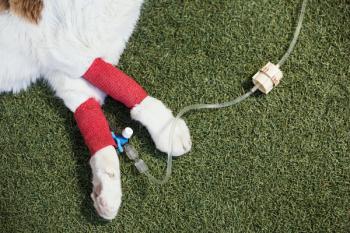
Bartonellosis: An emerging disease?
Bartonellosis may be a very important infectious disease just on the horizon in veterinary medicine. Its place in human medicine is becoming more firmly established on a daily basis. Will veterinary medicine soon follow?
Bartonellosis may be a very important infectious disease just on the horizon in veterinary medicine. Its place in human medicine is becoming more firmly established on a daily basis. Will veterinary medicine soon follow?
The Bartonella genus consists of facultative, intracellular, gram-negative, argyrophilic bacteria. These organisms tend to adhere to red blood cells and endothelial cells. These tendencies may contribute to the organism's ability to invade nearly every organ of the body. In people, a multitude of clinical syndromes have now been associated with this bacteria (see Table 1). The organism has been found in North America, Europe, Asia, Australia, South America and the Middle East.
Table 1
Most commonly we think of cat scratch disease, which is seen in immunocompetent individuals almost invariably associated with a feline encounter. There have been cases where cats have not been involved. It appears that the cat flea is involved in the spread of the bacteria. The organism has been found in the flea and flea feces. Few cases of humans bitten by fleas have been documented. In all likelihood, cats transmit the bacteria to people by depositing flea feces into human skin via a scratch or bite. People have developed the disease living with cats that have been declawed. The possibility of flea excrement in the environment entering an injury to a person's skin does exist. Recently, a Bartonella species was isolated from Ixodes scapularis ticks found on a cat living with a Bartonella infected woman in New Jersey and the dog flea in Japan. The significant prevalence of Bartonella seropositivity along with positive titers to E. canis and B. canis make the spread by other tick species likely.
The table of disease found in man contains many that are found in both dogs and cats. Could Bartonella cause some of these in our patients? Bartonella vinsonii was first isolated from a dog with endocarditis in 1993. At least eight other dogs with culture negative endocarditis and high antibody titers to B. vinsonii have been found. The organism was implicated as a cause of pyogranulomatous lymphadenitis in a dog. A large number of confirmed cases is lacking. However, it appears that this organism can cause myocarditis and resultant arrhythmias. In cases of endocarditis - lameness, bone pain and fevers may occur. Recent serologic evidence points to the likelihood of this organism contributing to the development of hemolytic anemias, non-regenerative anemias, cutaneous vasculitis resulting in dermatological lesions, polyarthritis, anterior uveitis and meningoencephalitis. Possible laboratory abnormalities may include neutrophilic leucocytosis, thrombocytopenia and anemia. Eosinophilia and monocytosis have been found. Isolation of the organism is extremely difficult. PCR and serology are the useful diagnostic tools. There appears to be a strong association of infection with Bartonella and tickborne diseases in the dog. A seroprevalence study involving close to 2,000 sick dogs from the southeastern United States showed 3.6 percent of the dogs were positive for B. vinsonii. Risk factors included heavy tick and flea exposure and living in a rural environment. However, in serum samples infected with E. canis or B. canis, 36 percent and 52 percent were reactive to B. vinsonii, respectively.
Currently, many cats around the country are being tested for Bartonella species. Prevalence rates in healthy cats vary from 7 percent in Minnesota to 17 percent in New Jersey, to 28 percent in Virginia. Controlled definitive studies have not been established. However, a possible association of Bartonella and a host of disease processes are becoming evident. Apparent Bartonella associated diseases including gingivitis, stomatitis, oral ulcers, conjunctivitis, sinusitis, fever, lymphadenopathy, uveitis and chorioretinitis. In some populations, almost 60 percent of affected animals are strongly positive for Bartonella. Cats with myocarditis, inflammatory bowel disease and neurologic abnormalities are testing positive. Risk factors are environment (shelter or stray), multicat household, fleas, living with a Bartonella positive cat or a person with cat scratch disease.
Therapeutic options include azithromycin, tetracycline and enrofloxacin. Antibody titers decline slowly and it may be six months before significant falls are detected.
It may very well be that we are on the cutting edge of finding the causative agent of some of our "idiopathic" diseases. Our job is to investigate the possibility of Bartonella as a culprit.
Transdermal medications
Several talks were given regarding the use of transdermal medications. Unfortunately, the scientific data supporting the use of delivering medication in this form is miserably deficient. Currently, there are at least four studies under way investigating diltiazem, odansetron, amitryptyline, busperone and EMLA. There is no available data from these studies. The take home message is the use of these formulations should be limited to drugs that have a measurable therapeutic endpoint. This could be heart rate, blood pressure, digoxin level or thyroid level for example. Factors that must be considered are:
- Is there a large margin of safety?
- What is the shelf life?
- Is the same vehicle used every time?
- What is the appropriate dose?
- Can you risk a therapeutic failure?
Until more data is available, practitioners need to proceed with caution when recommending medications administered by the transdermal route.
Newsletter
From exam room tips to practice management insights, get trusted veterinary news delivered straight to your inbox—subscribe to dvm360.



